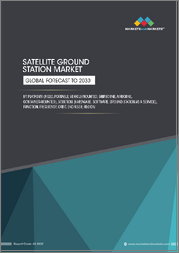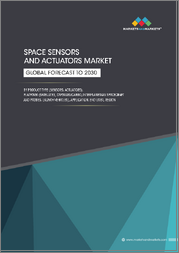
|
시장보고서
상품코드
1794369
유럽의 대형 위성 추진 시스템 시장 : 서브 시스템, 국가별 분석 및 예측(2025-2040년)Europe Large Satellite Propulsion System Market: Focus on Subsystem and Country - Analysis and Forecast, 2025-2040 |
||||||
유럽의 대형 위성 추진 시스템 시장 규모는 2040년까지 1억 7,750만 달러에 달할 것으로 예측됩니다.
유럽 시장의 대형 위성 추진 시스템에는 화학 추진, 전기 추진, 콜드 가스 추진, 하이브리드 추진기 등 다양한 궤도상 추진 기술이 포함되어 있으며, 모두 중량급 위성의 궤도 투입, 자세 유지, 운용 종료 시의 매뉴버에 필수적입니다.
이 지역 수요는 항행 위성 별자리의 확대, 고급 지구관측 플랫폼의 정비, 대용량 통신 위성의 전개 증가 등의 요인에 의해 계속 견인되고 있습니다. 이 모든 것은 고정밀 궤도 상승과 장기적인 자세 유지가 필요합니다.
유럽의 우주 사업자에게 확장 가능하고 경제적이고 지속 가능한 솔루션을 제공하기 위해 모듈형 하이브리드 스테이지, 그린 케미컬 추진 시스템 및 대 추력 전기 홀 효과 추진기와 같은 기술 혁신이 점차 채택되고 있습니다.
이 시장은 경쟁이 치열해 유럽의 기존 제조업체와 세계 항공우주 리더가 유럽 우주 기관(ESA) 및 각국의 우주 계획과 연계하고 있습니다. 사업자가 추진제 효율, 궤도 파편 감소, 미션 유연성에 중점을 두고 재사용 가능한 추진 시스템 및 차세대 전기 아키텍처에 투자하는 데 박차를 가하면 조달 전략이 진화하고 있습니다. 그 결과 유럽의 대형 위성 추진 시스템 시장은 기술 혁신, 민간 부문 진입 확대, 현대 위성 미션의 성능 수요 증가에 따라 빠르게 변화하고 있습니다.
시장 분류
세분화 1: 서브시스템별
- 화학 스러스터
- 추진제 탱크
- 펌프
- 연료 및 산화제 밸브
- 전기 스러스터
- 추진제 탱크
- 펌프
- 콜드 가스 스러스터
- 가스 저장 탱크
- 추진 챔버 및 노즐
- 펌프
- 하이브리드 슬러스터
- 추진제 탱크
- 추진실 및 노즐
- 펌프
세분화 2: 지역별
- 유럽
본 보고서에서는 유럽의 대형 위성 추진 시스템 시장을 조사했으며, 주요 동향, 시장 영향요인 분석, 법규제 환경, 기술 및 특허 분석, 시장 규모 추이와 예측, 각종 구 및 지역/주요 국가별 상세 분석, 경쟁 구도, 주요 기업 프로파일 등을 정리했습니다.
목차
주요 요약
시장/제품 정의
제1장 지역
- 대형 위성 추진 시스템 시장(지역별)
- 유럽
제2장 스러스터와 규제 분석
- 스러스터의 분석(용도별)
- 하이브리드 슬러스터
- 콜드 가스 스러스터
- 화학 스러스터(고온 가스 및 온 가스)
- 전동 스러스터
- 애널리스트의 시점
- 규제 분석(국가별)
- 영국
- 프랑스
- 독일
제3장 조사 방법
JHS 25.08.28This report can be delivered in 2 working days.
Introduction to Europe Large Satellite Propulsion System Market
The Europe large satellite propulsion system market is projected to reach $177.5 million by 2040. The European market for large satellite propulsion systems includes a variety of in-space thrust technologies, including as chemical, electric, cold-gas, and hybrid thrusters, all of which are necessary for heavyweight satellite orbit insertion, station-keeping, and end-of-life maneuvers. Demand in the area is still being driven by the expanding navigation constellations, sophisticated Earth observation platforms, and growing deployment of high-throughput communication satellites, all of which require precision orbit-raising and long-duration station-keeping. In order to provide European space operators with scalable, economical, and sustainable solutions, technological innovations like modular hybrid stages, green chemical propulsion systems, and high-thrust electric Hall-effect thrusters are being embraced more and more. The market is competitive, with both established European manufacturers and global aerospace leaders collaborating with organizations like the European Space Agency (ESA) and national space programs. Procurement strategies are evolving as operators place greater emphasis on propellant efficiency, orbital debris mitigation, and mission flexibility, fueling investment in reusable propulsion systems and next-generation electric architectures. Consequently, Europe's large satellite propulsion system market is undergoing rapid transformation, shaped by technological innovation, growing private-sector participation, and the escalating performance demands of modern satellite missions.
Market Introduction
The market for large satellite propulsion systems in Europe is constantly developing as a result of commercial satellite programs, aggressive government space efforts, and continued investments in cutting-edge in-space mobility technologies. Propulsion technologies, ranging from chemical and electric to cold-gas and hybrid systems, are essential for the insertion of heavy satellite orbits, station-keeping, attitude control, and deorbiting.
Demand across Europe is being driven by the expansion of high-throughput communication satellites, regional navigation constellations like Galileo, and next-generation Earth observation platforms. The European Space Agency (ESA) and national agencies in countries like France, Germany, and Italy are leading high-profile missions, while commercial aerospace businesses are increasingly contributing to innovation and manufacturing skills.
Technological advancements in the area include the increasing use of green chemical propulsion systems, modular hybrid stages made for cost-effectiveness and scalability, and high-thrust electric propulsion like Hall-effect thrusters. Global aerospace leaders and European manufacturers are working together to improve mission flexibility, debris mitigation techniques, and propellant efficiency.
The market for large satellite propulsion systems in Europe is expected to continue evolving due to technological advancements, strategic alliances, and the increasing performance requirements of contemporary satellite missions. This is because of the market's emphasis on sustainability, adherence to strict EU space regulations, and long mission lifetimes.
Market Segmentation
Segmentation: By Subsystem
- Chemical Thruster
- Propellant Tank
- Pump
- Fuel and Oxidizer Valve
- Electric Thruster
- Propellant Tank
- Pump
- Cold Gas Thruster
- Gas Storage Tank
- Propulsion Chamber/Nozzle
- Pump
- Hybrid Thruster
- Propellant Tank
- Propulsion Chamber/Nozzle
- Pump
Segmentation 2: by Region
- Europe
Europe Large Satellite Propulsion System Market Trends, Drivers and Challenges
Market Trends
- Increasing adoption of high-thrust electric propulsion systems, including Hall-effect thrusters, for geostationary and deep-space missions.
- Growing integration of green chemical propellants to meet EU sustainability and safety regulations.
- Expansion of European mega-constellation projects for broadband internet coverage.
- Rising use of modular and hybrid propulsion architectures to enhance mission flexibility.
- Strengthened collaboration between ESA, national agencies, and private aerospace firms for R&D and manufacturing.
Key Market Drivers
- Strong government funding through ESA and national space programs to advance indigenous propulsion technologies.
- Rising demand for high-throughput communication and Earth observation satellites in both civil and defense sectors.
- Strategic emphasis on space autonomy to reduce dependence on non-European propulsion systems.
- Growing commercial space activity driven by NewSpace companies across the region.
Challenges
- High development and qualification costs for next-generation propulsion systems.
- Stringent compliance requirements with EU space safety and debris mitigation policies.
- Competition from established non-European propulsion providers.
- Limited availability of certain raw materials and components, creating supply chain vulnerabilities.
How can this report add value to an organization?
Product/Innovation Strategy: The product segment helps the reader understand the different types of products available in the Europe region. Moreover, the study provides the reader with a detailed understanding of the large satellite propulsion system market by products based on propulsion subsystems.
Growth/Marketing Strategy: The Europe large satellite propulsion system market has seen major development by key players operating in the market, such as business expansion, partnership, collaboration, and joint venture. The favored strategy for the companies has been synergistic activities to strengthen their position in the large satellite propulsion system market.
Methodology: The research methodology design adopted for this specific study includes a mix of data collected from primary and secondary data sources. Both primary resources (key players, market leaders, and in-house experts) and secondary research (a host of paid and unpaid databases), along with analytical tools, have been employed to build the predictive and forecast models.
Table of Contents
Executive Summary
Market/Product Definition
1 Regions
- 1.1 Large Satellite Propulsion System Market (by Region)
- 1.1.1 Europe
- 1.1.1.1 Europe Large Satellite Propulsion System Market (by Subsystem)
- 1.1.1.2 Europe (by Country)
- 1.1.1.2.1 France
- 1.1.1.2.1.1 France Large Satellite Propulsion System Market (by Subsystem)
- 1.1.1.2.2 Germany
- 1.1.1.2.2.1 Germany Large Satellite Propulsion System Market (by Subsystem)
- 1.1.1.2.3 U.K.
- 1.1.1.2.3.1 U.K. Large Satellite Propulsion System Market (by Subsystem)
- 1.1.1.2.4 Rest-of-Europe
- 1.1.1.2.4.1 Rest-of-Europe Large Satellite Propulsion System Market (by Subsystem)
- 1.1.1.2.1 France
- 1.1.1 Europe
2 Thruster and Regulatory Analysis
- 2.1 Analysis of Thrusters (by Application)
- 2.1.1 Hybrid Thruster
- 2.1.1.1 Maneuvering and Attitude Control
- 2.1.1.2 End-of-Life Deorbiting
- 2.1.1.3 Orbit Transfer
- 2.1.1.4 Docking
- 2.1.1.5 Station Keeping (Impulse Bits)
- 2.1.1.6 In-Orbit Transportation
- 2.1.2 Cold Gas Thruster
- 2.1.2.1 Maneuvering and Attitude Control of Satellites
- 2.1.2.2 Astronaut Maneuvering (Spacewalk)
- 2.1.2.3 End-of-Life Deorbiting
- 2.1.2.4 Reaction Wheel Unloading
- 2.1.2.5 Orbit Transfer
- 2.1.2.6 Launch Vehicle Roll Control
- 2.1.3 Chemical Thruster (Hot and Warm Gas)
- 2.1.3.1 Maneuvering and Attitude Control
- 2.1.3.2 Landing Control for Interplanetary Landers
- 2.1.3.3 Launch Vehicle Roll Control
- 2.1.4 Electric Thruster
- 2.1.4.1 Maneuvering and Orientation Control
- 2.1.4.2 Primary Propulsion for Deep Space Missions
- 2.1.4.3 Attitude Control for Microsatellites
- 2.1.4.4 Station Keeping (Impulse Bits)
- 2.1.5 Analyst Perspective
- 2.1.1 Hybrid Thruster
- 2.2 Regulatory Analysis (by Country)
- 2.2.1 U.K.
- 2.2.1.1 The Space Industry Regulations 2021
- 2.2.1.2 European Space Agency (ESA) Industrial Policy Committee
- 2.2.1.3 European Cooperation for Space Standardization/Slovenian Institute for Standardization (SIST)
- 2.2.1.3.1 SIST EN 16603-35:2014
- 2.2.1.3.2 ECSS-E-ST-35-06
- 2.2.2 France
- 2.2.2.1 Centre National D'Etudes Spatiales (CNES)
- 2.2.3 Germany
- 2.2.3.1 Germany Federal Office of Economics and Export Control (BAFA)
- 2.2.3.1.1 Regulation (EU) 2021/821 - Dual-Use Export Controls
- 2.2.3.1 Germany Federal Office of Economics and Export Control (BAFA)
- 2.2.1 U.K.
3 Research Methodology
- 3.1 Data Sources
- 3.1.1 Primary Data Sources
- 3.1.2 Secondary Data Sources
- 3.2 Data Triangulation



















